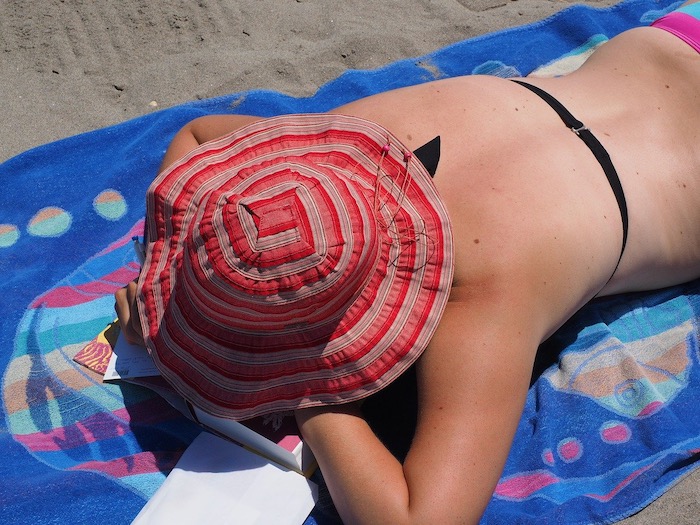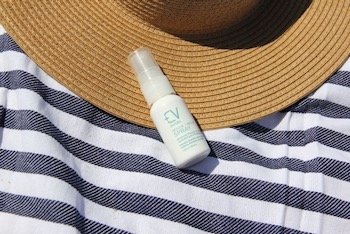
Are you addicted to tanning?
Answer these questions:
- Have you tried to quit tanning but found it difficult?
- Do you continue to tan even though you know it’s bad for your skin?
- Do you feel really good after tanning, emotionally?
If you answered yes to any of these questions, you may have an unhealthy tanning habit!
We can help. Read on to find out why this habit is so bad for you, and how you can keep your skin looking luscious without the danger of regular tanning.
 Why is Being Addicted to Tanning Bad for You?
Why is Being Addicted to Tanning Bad for You?
Getting a little sun is good for your health. (Read more in our post, “Sunshine Health Tips: Vitamin-D Friendly Ways to Prevent Skin Cancer.”)
When your skin is exposed to UV rays, it stimulates the production of vitamin D, which is important in maintaining a functioning immune system, growing strong bones, and even getting a good night’s sleep.
But tanning—particularly indoor tanning—increases your risk of skin cancer. Melanoma, the deadliest form of skin cancer, is linked to getting severe sunburns, especially at a young age.
In July 2009, the International Agency for Research on Cancer (IARC) concluded that tanning devices that emit UV radiation are more dangerous than previously thought. The IARC moved these devices into the highest cancer risk category: “carcinogenic to humans.”
Because the development of cancer can take decades, the IARC recommended banning indoor tanning for those younger than 18 years. They found that the risk of melanoma increased by 75 percent when tanning bed use started before the age of 35. They also found an association between tanning devices and eye cancer.
In one study of 63 women who were all diagnosed with melanoma before the age of 30, a surprising 97 percent of them had used tanning beds in their lifetime.
The Dangers of Being Addicted to Tanning
In addition to increasing your risk of skin cancer, regular tanning can also cause the following problems:
- Premature aging: Tanning damages the skin, causing it to lose its elasticity, degrading the collagen, and leading to premature wrinkles and sagging.
- Eye damage: Regular unprotected exposure to UV rays increases the risk of irreversible damage to the eyes.
- Allergic reactions: Some people who are sensitive to UV radiation may develop an allergic reaction to tanning. After that, tanning can cause itchy red rashes and other irritating skin conditions.
- Accelerated skin damage: Some proponents of tanning beds argue that they are safer than the sun since the time spent tanning can be controlled. There is no evidence to support these claims. On the contrary, because sunlamps in tanning devices are used at the same high intensity over and over again, they are considered more dangerous than the sun, which varies in intensity from day to day and season to season.
- Other serious injuries: Emergency rooms commonly treat other injuries from tanning beds like burns, loss of consciousness, and eye injuries.
- Lack of vitamin D: Unlike the sun, which combines UVA and UVB rays, tanning beds use light bulbs that emit mostly UVA light. Your body needs both types of light to make vitamin D, so if you get your tan mostly from tanning beds, you could be low on vitamin D.
When Did Tanning Become Addictive?
In recent years, scientists have discovered that tanning can be addictive—just like smoking and drinking or using drugs. According to the American Academy of Dermatology (AAD), about 20 percent of 18- to 30-year-old white women who use indoor tanning show signs of addiction.
Those signs may include:
- Finding it hard to stop tanning.
- Feeling restless or depressed when not tanning.
- Giving up other activities to be sure you can tan.
- Feeling uncomfortable or unattractive when you can’t tan.
In a recent study, researchers from Georgetown University Medical Center found that certain genes involved in pathways that reward addictive behavior were more prevalent in Hispanic women who tanned often.
In an earlier study of nearly 400 students at the University of Washington at Seattle, scientists found that 22 percent of women and 8 percent of men were likely addicted to UV light. Those who reported “yes” to two or more questions in a survey were categorized as addicted. The questions included:
- Have you ever felt you ought to cut down on tanning?
- Have people annoyed you by criticizing your tanning?
- Have you ever felt bad or guilty about your tanning?
- Have you ever thought about tanning first thing in the morning?
 How to Stop Being Addicted to Tanning
How to Stop Being Addicted to Tanning
If you feel that you may be addicted to tanning, what can you do about it?
Keep in mind that according to scientific research, sun exposure is beneficial in moderation, but harmful in excess. What is moderate for you is likely to be different than what is moderate for someone else. Your skin type, history of skin cancers, and other medical conditions can all affect your cancer risk.
For those who know they’re tanning more than they should, try the following tips to break the bad habit and nurture your skin back to good health.
1. Find Something Else that Makes You Feel Good
If tanning helps you relax or makes you feel good about yourself, you’ll need another activity to take its place before you’ll be successful and letting it go.
Some good options may include:
- getting a massage
- going for a mani-pedi or facial
- taking a long walk in the park
- spending time with a beloved pet
- sinking into a hot bubble bath
- any other activity that helps you shed stress and feel better about the world
2. Talk to Your Doctor About Being Addicted to Tanning
If you get feel-good hormones from your tanning, an addiction specialist may be able to help you break the association between tanning and happiness. They may prescribe medications that can treat addictions. These block the chemical response in your brain so that tanning no longer inspires that “high” that you enjoyed.
3. Use Sunless Tanning Products
Most people who tan do so at least partially because of how it makes them feel about their appearance. You can get that same summer glow with sunless tanning products and bronzers. These creams and lotions give you all the glow with none of the harmful effects.
4. Try a Lightbox
A lightbox can boost your mood in the same way that the sun does without the harmful UV rays. Get one that provides 10,000 lux. Turn it on for 30 minutes while eating breakfast and you’re likely to feel happier all day.
5. Find a Form of Exercise You Enjoy
Exercise releases the same feel-good endorphins that you may be getting from tanning. Find a workout that you enjoy and commit to it. If your current workout feels boring, try shaking it up by:
- streaming a new spinning class
- signing up for a dancing or yoga class
- joining a sports team
- pairing up with a friend for a regular walk or bike ride
6. Be Smart About Sun Exposure
You may be able to wean yourself off tanning by approaching it more safely.
- Avoid indoor tanning completely.
- Stay inside between 10 a.m. and 2 p.m. when the UV rays are at their most intense.
- Avoid spending excessive time in the sun in one session. It’s better to tan in shorter intervals.
- Wear a hat and sunglasses with broad-spectrum protection to shield the scalp and eyes.
- After a short period (10-30 minutes) in the sun, apply sunscreen.
7. Take Better Care of Your Skin
Perhaps the best thing you can do for yourself as you’re breaking your tanning habit is to take better care of your skin. Replace your tanning time with some careful “me time” spent giving your skin what it needs to recover.
Our CV Skinlabs products can help you reduce the damage done by the UV rays, taming inflammation and easing irritation. We also designed them to help reduce premature aging, with ingredients like aloe, Reishi mushroom, and vitamin E. Plus, they will fend off DNA-damaging free radicals.
Natural plant-based oils help restore the skin’s hydration while penetrating deeply to soothe stressed skin. Our unique Tri-Rescue Complex helps repair the skin barrier so skin can recover its smooth appearance.
Whatever skin care products you use, take your time and enjoy the process of applying them. (See our post, “How to Turn Your Skin Care Into Stress-Relieving Self-Care.”) Soon you’ll be looking forward to that weekly hydrating mask or oil-absorbing treatment and tanning will be a distant memory.
How did you break your tanning habit?
Sources
10 surprising facts about indoor tanning. (n.d.). American Academy of Dermatology. https://www.aad.org/public/diseases/skin-cancer/surprising-facts-about-indoor-tanning
Indoor tanning: The risks of ultraviolet rays. (2015, December 18). U.S. Food and Drug Administration. https://www.fda.gov/consumers/consumer-updates/indoor-tanning-risks-ultraviolet-rays
Mays, D., Ahn, J., Zhang, B., Atkins, M. B., Goerlitz, D., & Tercyak, K. P. (2019). Genetic associations with indoor tanning addiction among non-Hispanic white young adult women.
Annals of Behavioral Medicine, 54(1), 1-9. https://doi.org/10.1093/abm/kaz021
New study indicates tanning may be addictive. (2021, 20). ScienceDaily. https://www.sciencedaily.com/releases/2007/03/070319212951.htm
New study shows further evidence that indoor tanning is addictive. (2020, January 31). The Skin Cancer Foundation. https://www.skincancer.org/press/2018-new-study-shows-indoor-tanning-is-addictive/

